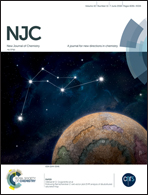Mechanism of generation of closo-decaborato amidrazones. Intramolecular non-covalent B–H⋯π(Ph) interaction determines stabilization of the configuration around the amidrazone C![[double bond, length as m-dash]](https://www.rsc.org/images/entities/char_e001.gif) N bond†
N bond†
Abstract
Three types of N(H)-nucleophiles, viz. hydrazine, acetyl hydrazide, and a set of hydrazones, were used to study the nucleophilic addition to the C![[triple bond, length as m-dash]](https://www.rsc.org/images/entities/char_e002.gif) N group of the 2-propanenitrilium closo-decaborate cluster (Ph3PCH2Ph)[B10H9NCEt], giving N-closo-decaborato amidrazones. A systematic mechanistic study of the nucleophilic addition is provided and included detailed synthetic, crystallographic, computational and kinetic work. As a result, two possible mechanisms have been proposed, which consist of firstly a consecutive incorporation of two Nu(H) nucleophiles, with the second responsible for a subsequent rapid proton exchange. The second possible mechanism assumes a pre-formation of a dinuclear [Nu(H)]2 species which subsequently proceeds with the nucleophilic attack on the boron cluster. The activation parameters for hydrazones indicate a small dependence on bond formation [ΔH‡ = 6.8–15 kJ mol−1], but significantly negative entropies of activation [ΔS‡ ranges from −139 to −164 J K−1 mol−1] with the latter contributing some 70–80% of the total Gibbs free energy of activation, ΔG‡. In the X-ray structure of (Z)-(Ph3PCH2Ph)[B10H9N(H)
N group of the 2-propanenitrilium closo-decaborate cluster (Ph3PCH2Ph)[B10H9NCEt], giving N-closo-decaborato amidrazones. A systematic mechanistic study of the nucleophilic addition is provided and included detailed synthetic, crystallographic, computational and kinetic work. As a result, two possible mechanisms have been proposed, which consist of firstly a consecutive incorporation of two Nu(H) nucleophiles, with the second responsible for a subsequent rapid proton exchange. The second possible mechanism assumes a pre-formation of a dinuclear [Nu(H)]2 species which subsequently proceeds with the nucleophilic attack on the boron cluster. The activation parameters for hydrazones indicate a small dependence on bond formation [ΔH‡ = 6.8–15 kJ mol−1], but significantly negative entropies of activation [ΔS‡ ranges from −139 to −164 J K−1 mol−1] with the latter contributing some 70–80% of the total Gibbs free energy of activation, ΔG‡. In the X-ray structure of (Z)-(Ph3PCH2Ph)[B10H9N(H)![[double bond, length as m-dash]](https://www.rsc.org/images/entities/char_e001.gif) C(Et)NHN
C(Et)NHN![[double bond, length as m-dash]](https://www.rsc.org/images/entities/char_e001.gif) CPh2], very rare intramolecular non-covalent B–H⋯π(Ph) interactions were detected and studied by DFT calculations (M06-2x/6-311++G** level of theory) and topological analysis of the electron density distribution within the framework of Bader's theory (QTAIM method). The estimated strength of these non-covalent interactions is 0.8–1.4 kcal mol−1.
CPh2], very rare intramolecular non-covalent B–H⋯π(Ph) interactions were detected and studied by DFT calculations (M06-2x/6-311++G** level of theory) and topological analysis of the electron density distribution within the framework of Bader's theory (QTAIM method). The estimated strength of these non-covalent interactions is 0.8–1.4 kcal mol−1.
![Graphical abstract: Mechanism of generation of closo-decaborato amidrazones. Intramolecular non-covalent B–H⋯π(Ph) interaction determines stabilization of the configuration around the amidrazone C [[double bond, length as m-dash]] N bond](/en/Image/Get?imageInfo.ImageType=GA&imageInfo.ImageIdentifier.ManuscriptID=C8NJ01018H&imageInfo.ImageIdentifier.Year=2018)


 Please wait while we load your content...
Please wait while we load your content...
![[double bond, length as m-dash]](https://www.rsc.org/images/entities/h2_char_e001.gif) N bond
N bond